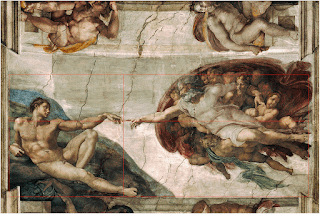Week 9: Space + Art
Few people would be shocked to hear that the human race was, and still is, fascinated by all things space. I think that part of this fascination comes from the fact that space is relatively unknown and most of the things about it will not be uncovered during any of our lifetimes.
 |
| Copernicus' work on the sun centered universe |
But, this does not stop people from wondering and trying. The wonder with space dates back to the times of the ancient Greeks and Romans, who named the planets after their gods and continued into Renaissance times with Galileo and Copernicus, one of the first to postulate that the earth rotated around the sun and not the other way around. Even today people continue to look to space as inspiration. Many works of science fiction deal with space exploration or colonization and, in doing so, create these fantastic images of a world just beyond our reach. Some artists have gone in the opposite direction and have captured what space looks like from our view rather than trying to create a whole new image of space. The most apparent example I can think of is The Starry Night by Van Gogh, which beautifully
illustrates the night sky light up with stars.
 |
| The Starry Night by Van Gogh |
Space has even crept into the political world, with the space race taking center stage during the Cold War. This competition between the US and the Soviet Union sparked a time of great technological innovations and engaged the public to a degree which has rarely been seen before. So prevalent in everyday life was the space race that it began to extend beyond just the aeronautics arena and inspired artists to create things like documentaries following the chimpanzees that were going into space to songs about the space race and Laika, the first living creature in space.
 |
| 1968 Time cover which is an example of how big of a role the space race had in life during this time period. |
Sources:
Vesna, Victoria. “Space Part 1.” DESMA 9. Lecture.
Vesna, Victoria. “Space Part 3.” DESMA 9. Lecture.
Leonardo Space Art Project Visioneers. N.p., n.d. Web. 01 June 2017
“Nicolaus Copernicus.” Wikipedia, Wikimedia Foundation, 28 May 2017, en.wikipedia.org/wiki/Nicolaus_Copernicus. Accessed 1 June 2017.
“The Starry Night.” Wikipedia, Wikimedia Foundation, 28 May 2017, en.wikipedia.org/wiki/The_Starry_Night. Accessed 1 June 2017.
“TIME Magazine Cover: Race for the Moon - Dec. 6, 1968.” Time, Time Inc., content.time.com/time/covers/0,16641,19681206,00.html?iid=sr-link6. Accessed 1 June 2017.


I enjoyed reading your blog. I loved that you integrated Van Gogh's art piece into your blog to show both Space and Art are connected. I also wrote about Laika in my blog and I found it interesting that animals were used a test subject before sending a man to space. What were your thoughts about using animals as test subjects? Do you think this is appropriate?
ReplyDeleteI liked your blog a lot. I think you have mentioned the key thing about art that is related to space. I believe it is not knowing the unknowns that stirs artists' creativity and imaginations and results in creation of valuable works of art. I liked the connection you made between history and future of space explorations very much. You could see a path or pattern in it. And you did a good job relating these topics to the interest of the public and the artists.
ReplyDeleteI really enjoyed reading your blog. I have always been curious about space and how people throughout human history have wondered what's out there. I really liked how you used Vincent Van Gogh's Starry Night to get your point across.
ReplyDelete